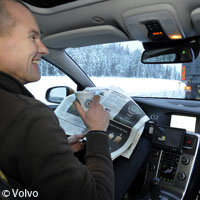Look - no hands! Smart convoy gives drivers a break
EU-funded scientists have successfully demonstrated a road train technology that could boost road safety and driver comfort while cutting congestion and carbon emissions. In the system, the driver of the lead vehicle of a convoy controls the other vehicles, allowing their drivers to safely engage in other activities. The technology is an outcome of the SARTRE ('Safe road trains for the environment') project, which is funded to the tune of EUR 3.8 million under the Transport Theme of the Seventh Framework Programme (FP7). The three-year project started in 2009 and its seven partners come from Germany, Spain, Sweden and the UK. The platooning concept links vehicles driving along motorways in convoys. The lead vehicle is driven by an experienced driver who knows the route well, and could be a taxi, bus or lorry, for example. The lead vehicle controls the following vehicles' acceleration, braking and steering by wireless technology. As well as following virtual 'breadcrumbs' left by the lead vehicle, convoy vehicles also use sensors to track the car directly in front of them and adjust their distance, speed and direction accordingly. When a vehicle wishes to join a convoy, the driver simply sends a request to the leader of the convoy. When the request is accepted, the convoy leader takes control of the vehicle, allowing the driver to sit back and relax, read a book, eat, drink, or use a computer or phone. When a driver wants to leave the convoy, he or she sends a signal to the leader to regain manual control of the vehicle and exit the convoy. The system automatically closes up the gap created. In the recent demonstration, at Volvo's test track near Gothenburg in Sweden, the SARTRE team tested a two-vehicle convoy in which a car followed a lorry. The car successfully latched on to the lorry and smoothly followed it around the course while the driver relaxed with a newspaper and a cup of coffee. At the end of the test, the car driver resumed control of his vehicle and left the convoy. 'We are very pleased to see that the various systems work so well together already the first time,' commented Eric Coelingh, an engineering expert at Volvo Cars. 'After all, the systems come from seven SARTRE member companies in four countries. The winter weather provided some extra testing of cameras and communication equipment.' Ultimately, the SARTRE team hopes to demonstrate the technology using a five-vehicle convoy comprising two lorries and three cars. Meanwhile the project coordinator, Tom Robinson of Ricardo UK, is extremely pleased with the outcome of the initial demonstration. 'This is a major milestone for this important European research programme,' he said. 'With the combined skills of its participating companies, SARTRE is making tangible progress towards the realisation of safe and effective road train technology.' The SARTRE technology tackles four major issues in the road transport sector: road safety, fuel consumption and carbon emissions, congestion, and driver comfort. The system contributes to road safety because it largely eliminates the human factor; as the team points out, 80% of accidents are caused by human error. Because vehicles in a convoy travel fairly close together, they are able to exploit the resulting lower air drag, something that is expected to cut fuel consumption (and so carbon emissions) by 20%. The compact nature of the convoys will also help reduce congestion. Finally, drivers benefit from the opportunity to relax or embark on other activities while in the convoy. The technology used in SARTRE is already at an advanced stage and the project partners predict that the system could be road ready in a few years. However, the real challenge will be to generate public acceptance of the concept and convince governments across Europe to pass laws legalising it.For more information, please visit: SARTRE:http://www.sartre-project.eu/ Ricardo:http://www.ricardo.com/ Volvo Cars:http://www.volvocars.com/ Transport research under FP7:http://cordis.europa.eu/fp7/transport/home_en.html
Countries
Germany, Spain, Sweden, United Kingdom



